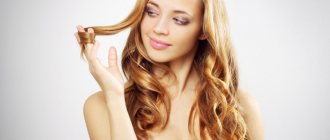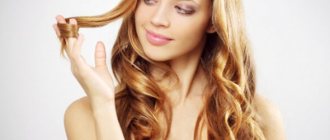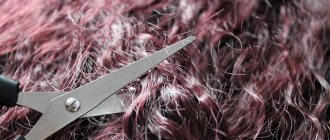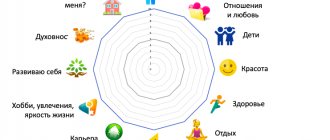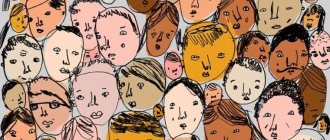Obsessive movements, including the manner of twirling your hair on your finger - psychology explains how the subconscious desire to calm down and get rid of tension. The rhythmic movements that occur during this type of action are transmitted to the hair follicles and cause sensations that make cats squint when scratching the area between the ears.
The habit of twirling strands around your finger has many reasons.
But, unfortunately, this habit is not as safe as it looks at first glance. It affects adults and children from birth to old age.
Toddler habits
The baby's first attempts to curl his hair are observed between the ages of 0 and 3 years. The older the child, the more varied the reasons may be that lead to a burning desire to tug at his hair.
In order for your baby to forget about the habit once and for all, provide him with absolute comfort and consistency.
Very little crumbs thus calm down and lull themselves to sleep. In addition, the little man’s constantly repeating “rituals” help him feel safe in this big world.
What should mom do?
At this age, it is important to create conditions that would eliminate the need for self-soothing.
- Be sure to follow a daily routine; its violation will lead to the fact that the child will have no choice but to resort to obsessive movements that create predictability and stability in his life.
- Occupy your baby's hands with a soft toy or a thin flannelette diaper. Using a personal example, show how wonderful and fun it is to wrap a hare’s ears, a fox’s tail, or a corner of a diaper around your finger.
Note! The child will often pull such toys towards his face, so they should be small in size and free of hard and sharp parts.
- If the measures described above do not help and the child still twirls his hair on his finger, deprive him of the physical ability to do this. Put on a light flannel cap or cut your baby's hair.
If the habit itself does not seem like a threat to you, then getting hair into a child’s mouth can lead to “Rapunzel syndrome,” in which a hairball causes intestinal obstruction.
Oh, these schoolchildren!
The desire to be the best often develops into fear and anxiety.
Among schoolchildren, the habit of twirling their hair around their fingers is more common among girls and is nothing more than a way of psychological protection from others.
You can fight this scourge before the age of 10 only by instilling absolute self-confidence in your child. If your son or daughter starts the hand-curling mechanism before public speaking (reciting a verse in class), memorize the verse so that the child is confident that he knows it best.
From the age of 10, children become critical of their own appearance. At this moment, twirling your hair around your finger indicates a desire to change yourself.
Tips for parents:
- If we are talking about a girl's long-suffering braid, give the young fashionista safe curlers. New styling and the desire to maintain it will eradicate the bad habit.
- Discuss with your child the structure of hair and how careless handling causes damage to it.
A few words about teenagers
In adolescence, curling one's hair is a conscious act, an expression of the desire to attract the attention of the opposite sex.
This action is inspired by cinema and, according to teenagers, makes them mysterious, romantic and touching.
Your goal is to debunk this myth.
- Convince the young lady that such a movement harms her image and makes her look the same in all situations . Let him try to portray thoughtfulness, interest or offense in front of the mirror and come up with appropriate gestures and poses.
- Find a movie that always features a hero twirling his hair in a ridiculous way around his finger . In most cases, the script assigns him the role of a cutesy and not very smart character. Review the film with your child, making a slight emphasis or remark on the hero.
- Teenagers have another problem - they do not know where to “adapt” their elongated arms . Playing sports or dancing will help solve the problem; the most suitable types are skating, roller skating, swimming and tennis.
Instructions on how to deal with teenage awkwardness. Sports and only sports!
Frequently combing hair: benefits and harms
Did you know that combing your hair is not just a procedure for detangling it? In the process, you cleanse your hair of dust and dirt particles, and also distribute fatty secretions from the surface of the head over the entire length of the hair.
Hair needs combing. It allows you to bring natural oils from the scalp to dry ends, moisturizing the hair along the entire length. But excessively frequent combing leads to hair breakage and destruction. 100 times is too much! Limit yourself to combing 15-20 times, this will be more than enough. When doing this, use a comb with 100% natural bristles (for example, boar), never pull your hair when combing and be as gentle as possible with it.
The question of the benefits and harms of combing your hair depends on how you do it and what you do it with.
It is harmful to comb your hair if:
- they are wet
- they are very tangled and you start combing them from the roots, and not from the ends,
- you use a comb made of poor material, which electrifies your hair and breaks your hair.
It is useful to comb your hair:
- a good comb, brush (ebonite, bone, wood, natural bristles),
- a hundred times a day, tilting your head and in different directions,
- do aromatherapy - combing, dropping a little essential oil, which will strengthen the hair and make it smell pleasant,
- when the hair is already dry, carefully, starting from the ends.
Most long-haired ladies tend to comb their hair as often as possible, thinking that this way they can make their curls shiny and beautiful. Experts are convinced of the opposite. The more you brush your hair, the more friction you create, which leads to cuticle damage. For best results, experts recommend stopping brushing your hair frequently and giving it some rest.
Although combed hair looks more beautiful and neat, the combing process often leads to splitting of the ends of the hair, as well as hair loss. Therefore, you should not comb your hair too often.
You also need to learn how to comb your hair correctly. Firstly, this must be done with smooth movements, starting from the ends and gradually moving up. Secondly, it is better not to use combs and brushes with hard teeth or bristles - this will only harm your hair.
Non-childish problems with adult consequences
If an adult girl twirls her hair around her finger, this indicates her desire to calm down. Often, parents of adult children recall that they had the same habit in their distant childhood.
And even if in your youth you managed to overcome the problem with your own hands, then when mental stress or a conflict situation arises, the brain “remembers” how it organized self-soothing.
The desire to constantly tug at your hair is also common among Hollywood stars (photo by Jennifer Aniston)
The price of ignoring the problem and unwillingness to get rid of it is the possibility of becoming a hostage to a serious psychological illness - trichotillomania.
A harmless habit that developed into trichotillomania
In the scientific literature, this disease is described as hair pulling out. The disease occurs in people with an unbalanced psyche or against the background of a stressful situation. More often, the disease affects the fair half of humanity and is often combined with trichophagia (the desire to eat hair).
Interesting to know! Trichotillomania was first described by the French dermatologist F. A. Allopeau more than 125 years ago. At the moment, it is observed not only in adults, but also in children and is associated with severe psychological trauma and excessive demands on the part of parents.
Frequently combing your hair how to comb your hair correctly
Daily combing of hair with a comb helps improve blood circulation in the scalp, release the secretions of the sebaceous glands and distribute them evenly along the hair. How long does it take to comb? Even in the time of our grandmothers, it was believed that a hundred daily brushings were a sure way to have healthy, beautiful and shiny hair. Take this amount as the required minimum.
How should you comb your hair?
- Choose a comb with blunt ends, as sharp ones can scratch your scalp.
- If you have long hair, then it is better to start combing it from the middle. Short hair can be combed starting from the roots.
- It is recommended to comb long hair first with a brush and then with a comb. Owners of short hair are not advised to use a brush, replacing it with a comb when caring for their hair.
- Whatever you decide to use to comb your locks, make sure your device is clean. Do not give your hair care device to another person, as this can transmit lice and fungal microorganisms to you.
- Be careful not to pull your hair when combing.
- If you have long hair and it is difficult to manage, then grab it with your hand near the root and comb it strand by strand.
- Don't forget to wash your combs and combs. Of course, this should not be done as often as washing your hair, but at least once a week.
- To improve hair circulation, comb while lying down.
- The movements should be soft, comb yourself lovingly.
- The optimal time for combing is 3-5 minutes. At least once a week, devote this much time to your hair.
Daily combing of hair with a comb helps improve blood circulation in the scalp, release the secretions of the sebaceous glands and distribute them evenly along the hair.
How to comb your hair? To improve blood circulation, hair should be combed while lying down. Lie down on the sofa with your head hanging over the edge of the sofa. You need to start from the back of your head in all directions - after 3-5 minutes you will feel a more pleasant sensation of warmth. This warmth is a sign of increased blood circulation in the scalp: as a result, additional nutrients are deposited in the hair papillae, the hair becomes stronger, gains strength and health, and grows better.
Another option for combing your hair is to sit on a sofa or chair and bend your head between your knees while combing your hair. The same can be done while standing and leaning forward. The tilt is needed here because it promotes blood flow to the scalp. It is not recommended for those who have problems with blood pressure to stay in this position for a long time.
When combing your hair, you need to alternate movements of the comb with stroking the hair with the palm of your free hand. One movement with the comb, and then a second with the palm. You can also stroke already combed hair for a few minutes. This distributes sebum along the entire length of the hair, making it shiny, elastic and strong.
We recommend reading: Oily hair and dry ends.
Lena
Posted 04/19/2017
Hello! My daughter (almost 5 years old) has recently started crying often because she regrets things. For example, he asks not to throw away the shells of painted Easter eggs - “I like them so much.” Or because of spilled water - “will you pour me the same amount as there was?” Asks to save all kinds of candy labels. Moreover, if I tell her that I will save them, she immediately forgets about them and stops crying. In addition, he refuses to go to kindergarten, saying that he misses me a lot there. Although before that it was quite normal to go there. Tell me what could be causing this disorder. I also started twirling my hair on my finger.
Answer
Author
Tamara (shpilki.net)
Lena Posted 04/19/2017
Hello, Lena. In children, curling hair on a finger is a primary sign of neurotic disorders that arise against the background of deprivation from the mother (in other words, separation and lack of maternal love) or as a defensive reaction of the child’s psyche to sudden changes (in the family, place of residence, etc.). This problem is not an aesthetic one, so you need to seek advice from a child psychologist. A specialist will be able to identify the causes of the problem and, using specially selected techniques, help your daughter cope with uncertainty and fears. Do not delay with therapy; it will be more difficult to treat during the school period.
Answer
Text \ Photo Ekaterina Posted 05/28/2015
+5
share:
To favorites
To print
If you want to thank, add clarification or objection to the author - add a comment!
Currently being discussed:
- Lyubov Burkina
20.08.2018
What hair color should I choose? Please give me some advice. I don't know which one I have...
- I
19.08.2018
I had eyelash extensions for 6 months and took a break. After 3 months I increased it again...
- Vasilisa
18.08.2018
Cool hairstyle
18.08.2018
Hi, can I dye my bleached hair (currently red) bright purple...
16.08.2018
Hello! I am a dark girl with black eyes. I want to dye my hair dark...
15.08.2018
The photo shows young beauties. Can older ladies have their eyebrows done? Age...
Comments »
